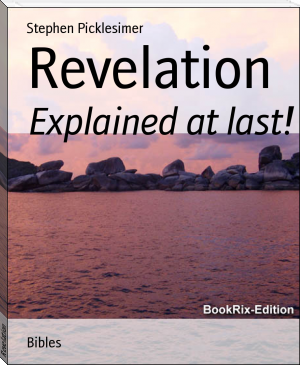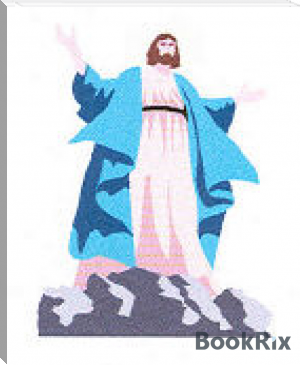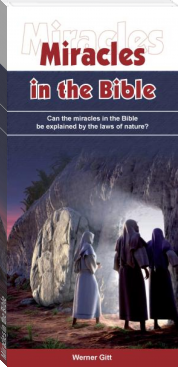Revelation, Stephen Picklesimer [summer reading list .txt] 📗

- Author: Stephen Picklesimer
Book online «Revelation, Stephen Picklesimer [summer reading list .txt] 📗». Author Stephen Picklesimer
Fifth, in Matthew 24:21-24:22, Christ explains that the Great Tribulation occurs. Sixth are the Heavenly Signs (Matt. 24:29)—when the stars fall and the sun and moon are darkened. The sign of Christ’s coming (Matt. 24:30) occurs at this same time. His actual coming is right on the heels of it.
We will now examine Revelation, chapter by chapter.
Chapter 1: Christ the Revelator and the Book’s Theme
Understanding who is the actual author of the Revelation—and understanding the critically important theme, the centerpiece of the book, is vital. Without these keys, many have bogged down into either arguments about whether “the Lord’s Day” (vs. 10) is a reference to Sunday—or whether John, instead of Christ, authored the book.
Why does almost everyone refer to this book as “The Revelation of St. John the Divine”? Nowhere does it refer to John as either divine or the Revelator.
Notice: “The Revelation of Jesus Christ, which GOD GAVE unto Him, to show unto His servants things which must shortly come to pass; and He sent and signified it by His angel unto His servant John: who bare record of the word of God, and of the testimony of Jesus Christ, and of all things that he saw” (vs. 1-2).
Did you notice that the book of Revelation contains Jesus Christ’s words, as the Revelator, not John’s words? John was merely a scribe—a secretary taking dictation.
Anyone who carefully examines this verse will plainly see that the Revelation originated with God (the Father), who gave it to Christ. Christ sent and signified the Revelation by His angel, who then gave it to John, “who bare record of the word of God, and of the testimony of Jesus Christ, and of all things that he saw” (vs. 2). John merely recorded these events, preserving them for the servants of Jesus Christ—His end-time Church.
As soon as the book was copied and canonized (circa A.D. 100), the founders of the developing universal church at Rome denied its origin. The highly authoritative, and famous 11th edition of The Encyclopaedia Britannica states, “Instead of this [Rev. 1:1] the Church substituted the name of the disciple through whom the message was delivered for that of his Master, and designated our Apocalypse ‘The Apocalypse of John.’ This title was familiar before the end of the 2nd century” (vol. 23, p. 212).
If the world’s best minds cannot even discern the book’s correct title—and Author—how could they discern its message?
Christ used John to “bare record of” (vs. 2)—write down—what He was revealing. In short, John wrote three things: (1) The word of God, (2) the direct testimony (words) of Christ, and (3) what he saw in vision.
With this background, you now understand the introduction to the book.
The Theme
Most scholars generally suppose that the term “the Lord’s Day” is, in fact, a reference to God’s coming day of reckoning, or judgment upon the world—THE DAY OF THE LORD!
Yet almost no one understands the truth. Without the understanding of this verse correct in one’s thinking, the entire book will make no sense. Reading Revelation becomes a fruitless exercise.
Now notice verse 10. This verse actually reveals the central focus or theme of the whole book. Understand that John lived 1,900 years ago—long before the events of this book were to be fulfilled. He wrote, “I was in the Spirit on the Lord’s day, and heard behind Me a great voice, as of a trumpet.”
Centuries of controversy have sprung from this reference, because people argue about which day of the week John is referring to. The presumption is that he is talking about Sunday, though the prophecy says nothing of the kind. This verse has nothing to do with Sunday—and is not a reference to any day of the week! The day of the week on which John may have received this prophecy is irrelevant.
The “Lord’s Day” is here speaking of the overall period of world trouble. This includes the Great Tribulation and the year-long Day of the Lord. Over thirty different Old Testament prophecies refer to “the great and terrible day of the LORD.”
The prophet Joel speaks of it. Here is a small portion of how he describes the day: “Blow you the trumpet in Zion, and sound an alarm in My holy mountain: let all the inhabitants of the land tremble: for the DAY OF THE LORD comes, for it is near at hand; a DAY of darkness and of gloominess, a DAY of clouds and of thick darkness, as the morning spread upon the mountains: a great people and a strong; there has not been ever the like [this is the worst time in history], neither shall be any more after it, even to the years of many generations. A fire devours before them; and behind them a flame burns: the land is as the garden of Eden before them, and behind them a desolate wilderness; yes, and nothing shall escape them” (2:1-3).
The prophet Zephaniah is even more graphic: “Hold your peace at the presence of the Lord GOD: for the DAY OF THE LORD is at hand: for the LORD has prepared a sacrifice, He has bid His guests. And it shall come to pass in the day of the LORD’S sacrifice, that I will punish the princes and the kings’ children, and all such as are clothed with strange apparel. In the same day also will I punish all those that leap on the threshold, which fill their masters’ houses with violence and deceit. And it shall come to pass in that day...” (1:7-10).
A few verses later, Zephaniah gives more insight into just how terrible this time will be. Consider this sobering picture: “The great day of the LORD is near, it is near, and hastes greatly, even the voice of the day of the LORD : the mighty man shall cry there bitterly. That day is a day of wrath a day of trouble and distress, a day of wasteness and desolation, a day of darkness and gloominess, a day of clouds and thick darkness, a day of the trumpet and alarm...And I will bring distress among men, that they shall walk like blind men, BECAUSE THEY HAVE SINNED AGAINST THE LORD: and their blood shall be poured out as dust, and their flesh as the dung” (vs. 14-17).
This presents a horrible picture. Verse 18 refers to this time as “the day of the LORD’S WRATH.” Verse 17 identifies the cause of God’s Wrath: “because they [all mankind] have sinned against the LORD.”
Events depicted here—God’s time of punishment—are almost more awful and terrifying than words can describe. This day literally belongs to God. Man’s conduct has made God angry. And He will soon intervene in the affairs of this world and send horrific plagues on a sinning mankind.
The Day of the Lord is the truly terrible time of God’s punishments, plagues and judgments at the culmination of 6,000 years of mankind’s practice of sin. Christ, through John, is revealing to His servants what occurs prior to—and through—His Return! The time setting of Revelation 1:10 is in relation to the Great Tribulation, including the Day of the Lord.
Ezekiel 8:3 gives some insight into how John could be transported 1,900 years into the future. Notice: “The spirit lifted me up between the earth and the heaven, and brought me in the visions of God to Jerusalem.” Like Ezekiel, John was in vision—“in the spirit”—from the Isle of Patmos, where he recorded the Revelation. God projected His servants (through visions) into important future events so that they could record them.
We are in the time of the end, when God wants His servants to understand the last events preceding the Return of Christ. The book of Revelation does not speak to unknown events in the distant past. It warns of colossal events that spring from world troubles affecting the masses of humanity alive now. Grasp that the Day of the Lord is the towering centerpiece of the entire book. Thus, it has required more explanation to understand what we will read in the balance of this booklet.
In Revelation 1:3, God states, “…he that reads, and they that hear the words of this prophecy, and keep [obey] those things which are written” are “blessed.” What would be the point of this verse if God did not want the reader—the “hearer”—the “keeper” (obeyer)—to understand it? This is an important statement to all who read the book. It means you!
Verses 14-16 are a direct description of Christ, as He now exists in full glory. This is an awe-inspiring picture. Take a moment to meditate on it—and how it is a far cry from the common image of the popular long-haired, sallow-complexioned, sad-faced, false “Christ” of this world: “His head and His hairs were white like wool, as white as snow; and His eyes were as a flame of fire; And His feet like unto fine brass, as if they burned in a furnace; and His voice as the sound of many waters. And He had in His right hand seven stars: and out of His mouth went a sharp two-edged sword: and His countenance was as the sun shines in his strength.”
There are two types of symbols used in the first chapter of Revelation. One is mentioned in verse 12, where John saw “seven golden candlesticks.” Also, in verse 16, he saw “seven stars” in Christ’s hand.
Their meaning is explained by simply continuing to read the context. The explanation is in verse 20: “The mystery of the seven stars which you saw in My right hand, and the seven golden candlesticks. The seven stars are the angels of the seven churches: and the seven candlesticks which you saw are the seven churches.”
Remember, the Bible interprets itself! And we have just introduced the subject of the next two chapters.
Chapters 2 and 3 contain Christ’s messages to seven different churches in Asia Minor—today’s western Turkey. Combined, these messages represent the first overall message of the book. They are directed to the seven successive eras, or stages, of the Church, and span the entire New Testament period—from the time Christ built His true Church (Matt. 16:18) in A.D. 31, until His Second Coming! God has chosen





Comments (0)